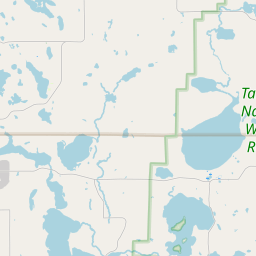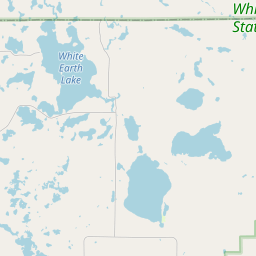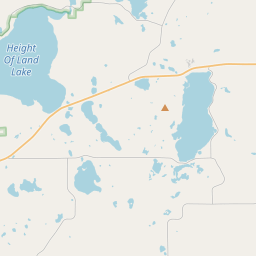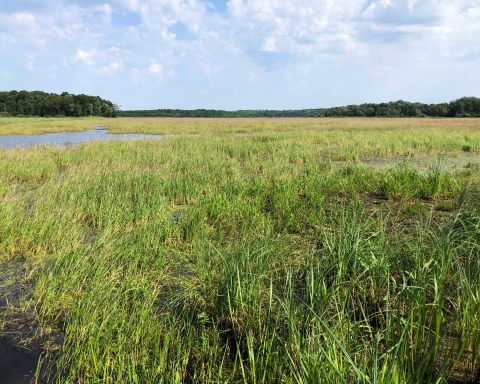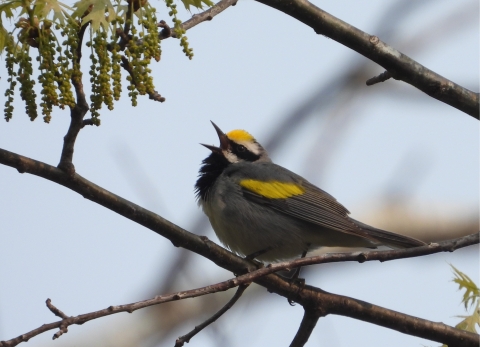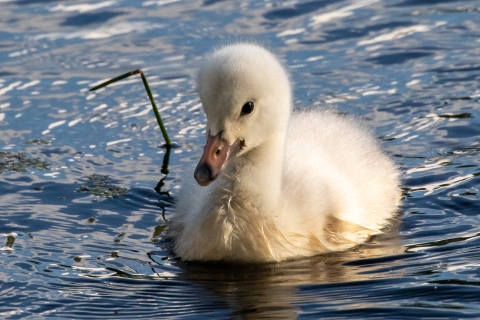Visit Us
Tamarac National Wildlife Refuge lies in the heart of one of the most diverse transition zones in North America. Here eastern deciduous hardwoods, northern coniferous forests and western tallgrass prairie converge - creating a rich assemblage of both plants and animals. Tamarac National Wildlife Refuge was established as a refuge and breeding ground for migratory birds and other wildlife by Executive Order 7902, dated May 31, 1938. A portion of the refuge is congressionally designated wilderness.
Though the landscape has been altered by the influences of human history and past management, the refuge remains largely intact with a functioning ecosystem and retains an untamed character for current visitors to enjoy, use and respect. From the vibrant emergence of spring woodland wildflowers to the rich colors of autumn to the quiet hush of winter, people come to revitalize their spirit and connect with a rich wildlife heritage.
The refuge is home to a large population of nesting trumpeter swans. Habitat conservation efforts address species such as the nearly threatened golden-winged warbler, woodcock, and ring-necked ducks. You’ll find Minnesota state icons including the common loon, showy lady’s slipper, red pine tree, morel mushrooms, wild rice and walleye.
Visitor Center
The Tamarac visitor center offers spectacular views of the marshes and trees typical of the refuge. It features active bird feeders, habitat and history displays, and a 15 minute feature film entitled Rhythms of Refuge: A seasonal journey of Tamarac. The center is open seasonally May 15 to October 15, Tuesday through Friday 9:00- 4:00 pm, Saturday and Sunday 10:00-4:00 pm. January and February the center is open Sundays 12:00 - 4:00 pm with free snowshoe rental. It is closed all federal holidays.
Location and Contact Information
- Tamarac National Wildlife Refuge and Visitor CenterView Details35704 county Hwy 26 Rochert, MN 56578
About Us
Tamarac National Wildlife Refuge lies in the heart of one of the most diverse transition zones in North America. Here eastern deciduous hardwoods, northern coniferous forests and western tallgrass prairie converge - creating a rich assemblage of both plants and animals. Tamarac National Wildlife Refuge was established as a refuge and breeding ground for migratory birds and other wildlife by Executive Order 7902, dated May 31, 1938. A portion of the refuge is congressionally designated wilderness.
Though the landscape has been altered by the influences of human history and past management, the refuge remains largely intact with a functioning ecosystem and retains an untamed character for current visitors to enjoy, use and respect. From the vibrant emergence of spring woodland wildflowers to the rich colors of autumn to the quiet hush of winter, people come to revitalize their spirit and connect with a rich wildlife heritage.
The refuge is home to a large population of nesting trumpeter swans. Habitat conservation efforts address species such as the nearly threatened golden-winged warbler, woodcock, and ring-necked ducks. You’ll find Minnesota state icons including the common loon, showy lady’s slipper, red pine tree, morel mushrooms, wild rice and walleye.
White Earth Nation and Tamarac National Wildlife Refuge Co-Stewardship
Building on our shared conservation partnership
We developed a memorandum of agreement with the White Earth Band of the Minnesota Chippewa Tribe, also referred to as White Earth Nation, that supports our long-standing conservation partnership. Band members have harvested resources in the area that is now the refuge since time immemorial. Certain activities such as wild rice harvest and furbearer trapping were guaranteed to the Tribe through an agreement with the Department of the Interior in 1935.
Additionally, we developed a co-stewardship agreement with the Tribe to increase coordination and collaboration on the refuge. The memorandum of agreement and the co-stewardship agreement do not transfer any refuge lands or change public access to the refuge. Instead, the agreements focus on how we collaborate and coordinate with White Earth Band of the Minnesota Chippewa Tribe.
Tours
If you have one hour:
- Stop by the visitor center to view the exhibits, step out onto the observation deck to look for trumpeter swans, loons and other wildlife on Jim’s Marsh. Watch the refuge video. Check out the pollinator garden. Shop at the Friends of Tamarac Nature Store.
- Hike the half mile Discovery Loop Trail, located next to the visitor center
- Take a scenic journey on the five mile Blackbird Wildlife Drive, stopping at the observation platform overlooking Blackbird Lake
If you have half a day or more, consider adding these activities:
- Walk or snowshoe in the footsteps of the Ojibwe people through the maple basswood forest on the 2.4 mile Old Indian Hiking Trail
- Stop at the Chippewa Picnic Area for a walk along the Otter Tail River bird watching
- Try your luck at fishing whether it’s summer or winter on Tamarac Lake
- Take in some solitude while kayaking or canoeing on the quiet and pristine Lost Lake
- Hike a stretch of the North Country National Scenic Trail
- Get up early on a crisp fall day and go hunting for deer, ducks or ruffed grouse
- Learn more about the nature around you by attending an interpretive program or workshop and become inspired
What We Do
The National Wildlife Refuge System is a series of lands and waters owned and managed by the U.S. Fish and Wildlife Service. Wildlife conservation is at the heart of the refuge system. It drives everything we do from the purpose a refuge is established, to the recreational activities offered there, to the resource management tools we use. Selecting the right tools helps us ensure the survival of local plants and animals and helps fulfill the purpose of the refuge.
Our Species
In the late 1880s, trumpeter swans disappeared from Minnesota. In 1987, we joined with state biologists to assist in their efforts to restore these magnificent birds and the first of several young adults was released in Jim’s Marsh. Today there are more than 50 successful nesting pairs on Tamarac National Wildlife Refuge and there are an estimated 17,000 birds around the state. The comeback of the trumpeter swan has been described as one of the most successful restorations of a once-endangered wildlife species. Listen for their brassy call and look for them loafing among beds of wild rice. Although they can be seen year round at the refuge, April through October is the best time for viewing.
The golden-winged warbler is a small migratory bird with a distinct black facial pattern similar to that of chickadees. Minnesota provides breeding habitat for 42% of the entire global population of this warbler and the refuge provides ideal habitat for this species. Golden-wing populations are declining throughout all of their range, with the current population being less than a fourth of what it was 40 years ago - one of the steepest declines of any North American species. Refuge researchers have studied habitat preferences, nesting success and other critical information about this declining species. Partnering with the American Bird Conservancy, we’ve been enhancing nesting habitat for these birds.
Listen for the "zee bee bee bee" along the woodland edges of lakes in the spring and in early successional forests with sparse trees and shrubs through the summer.
The gray wolf is elusive, however some visitors do have the opportunity to catch a glimpse of this powerful forest dweller. Wolves are social animals that live in groups, called packs. Biologists estimate that there are two packs using the refuge. A monitoring program was initiated several years ago giving insight to the wolf activity on the refuge. The recovery of the wolf population in the Great Lakes area has been a success. Minnesota’s wolf population has been above federal recovery goals since 1989. The state’s management plan will ensure the long-term survival of this species and we will continue to monitor wolf populations.
Get Involved
Whether you want to further conservation, learn more about nature or share your love of the outdoors, you’ve come to the right place. National wildlife refuges provide many opportunities for you to help your community by doing what you love. We work with volunteers, youth groups, landowners, neighbors and residents of local communities to make a lasting difference. Find out how you can help make American lands healthier and communities stronger while doing something personally satisfying.
Projects and Research
Refuges use a wide range of land management tools based on the best science available. Tamarac National Wildlife Refuge uses prescribed fires to mimic natural fires that would have cleared old vegetation from the land helping native plants regenerate and local wildlife to thrive. The refuge also contains wilderness areas where land is largely managed passively. The management tools used are aimed at ensuring a balanced conservation approach where both wildlife and people will benefit.
Tamarac National Wildlife Refuge is restoring native plant communities dominated by red, white and jack pine through natural succession and forestry practices including tree planting and natural processes such as fire.
Management of the lakes, rivers and wetlands is through natural fluctuations of water levels where possible. There are a few lakes that are still being managed via water control structures for the benefit of wild rice and other aquatic vegetation that support migrating waterfowl.
The refuge uses a limited prescribed fire program to aid in reforestation and wetland restoration projects. Prescribed fire is currently being used to maintain open sedge meadows for benefit of wetland dependent birds such as yellow rails and American bitterns.
Controlling invasive species invasive species
An invasive species is any plant or animal that has spread or been introduced into a new area where they are, or could, cause harm to the environment, economy, or human, animal, or plant health. Their unwelcome presence can destroy ecosystems and cost millions of dollars.
Learn more about invasive species through early detection and treatment is an important part of the resource management plan for the refuge.


